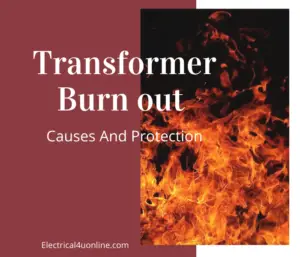Transformers play a crucial role in electrical systems, facilitating the efficient transmission and distribution of electricity.
As part of safe electrical practices, grounding is an essential consideration. Grounding helps protect both people and equipment from electrical faults, ensuring the system operates within acceptable limits.
In this article, we will explore the topic of grounding transformers, specifically addressing the question of whether both sides of a transformer should be grounded.
As a short answer, Grounding both sides of a transformer is not an absolute requirement. While grounding both sides can offer benefits such as stable voltage levels and improved system performance, I will break this down for you! let’s get started.
Table of Contents
Grounding in Electrical Systems
Grounding serves several purposes in electrical systems. It helps stabilize voltage levels, provides a low-impedance path for fault currents to dissipate safely, and reduces the risk of electric shocks.
There are two primary types of grounding: equipment grounding and system grounding. Equipment grounding focuses on grounding metal parts and enclosures, while system grounding involves grounding the power system itself.
Grounding Methods
There are different methods of grounding, including solid grounding, resistance grounding, and reactance grounding.
Solid grounding involves connecting the neutral point of the power system to the earth. Resistance grounding utilizes a resistor in the grounding path to limit the fault current magnitude.
Reactance grounding employs an inductor or reactor in the grounding circuit, allowing limited fault current to flow.
Grounding Transformers
Grounding transformers are specifically designed to provide a neutral connection for grounding purposes.
They are typically used in systems where the neutral point of the power source is not accessible or cannot be grounded directly.
Grounding transformers enable an effective neutral-ground connection, promoting system stability and safety.
Read also my article: The Importance of Transformer Neutral Grounding for Electrical Safety
Grounding Transformer Configuration
Grounding transformers can be configured as single-phase or three-phase. Single-phase grounding transformers are used in systems with single-phase loads, while three-phase grounding transformers are employed in systems with three-phase loads.
The appropriate configuration is chosen based on the specific requirements of the electrical system.
Grounding Practices for Transformers
Regarding grounding transformers, it is essential to consider both the primary and secondary sides.
Grounding the primary side involves connecting the neutral point of the primary winding to the earth while grounding the secondary side entails connecting the neutral point of the secondary winding to the earth.
Grounding Both Sides of a Transformer
Grounding both sides of a transformer offers certain benefits. It helps maintain a stable voltage level, reduces the risk of insulation failure, and limits transient overvoltages.
Grounding both sides can also improve the overall performance and reliability of the electrical system.
However, there are potential issues to consider when grounding both sides of a transformer.
- One concern is the creation of ground loops, which can introduce unwanted circulating currents and lead to electromagnetic interference (EMI) or other operational problems.
- Additionally, grounding both sides may increase the fault current magnitude during a fault condition, impacting protective devices and equipment.
Alternatives to Grounding Both Sides
In situations where grounding both sides of a transformer may not be feasible or recommended, alternatives can be considered.
One option is grounding only one side, typically the secondary side if it is more practical or meets specific system requirements.
Another alternative is neutral grounding, which involves grounding the neutral point of the transformer only, without grounding the secondary neutral.
Factors Influencing Grounding Decisions
Several factors influence the decision of whether to ground both sides of a transformer.
System requirements and specifications, electrical codes and standards, equipment manufacturer recommendations, and safety considerations all play a role in determining the appropriate grounding approach.
Case Studies and Examples
Real-world examples and case studies can provide insights into grounding practices for transformers.
In industrial settings, grounding practices may vary depending on the specific application and requirements.
Similarly, residential applications have their own grounding considerations, taking into account factors such as load types and residential codes.
Conclusion
Grounding transformers are a vital aspect of electrical system design and operation. While grounding both sides of a transformer offers benefits in terms of stability and reliability, it is important to carefully consider potential issues and alternatives.
Following recommended guidelines, industry standards, and safety considerations ensures a well-grounded system that promotes electrical safety and optimal performance.
As technology advances, future trends and developments in transformer grounding will continue to shape the field.
Don’t Leave Empty-Handed!
Install my Free Android App on Google Play:
Electrical Cables Most Common Tables “Cables Tables”
And, my Electrical Calculations App “Fast Electrical Calculator”
Discover more great content by subscribing to My channel
Looking to stay ahead of the game in the world of electrical engineering? Subscribe to my YouTube channel and gain access to exclusive content you won’t find anywhere else!
The staff I recommend
(Amazon Affiliate Links to products I believe are high quality):
- Economy 120 Volt/60Hz AC Power Source – Step-Down Voltage & Frequency Converters 1800W
- UNI-T Digital Multimeter Tester UT139C
- 50-Amp Extension Cord for RV “100ft”
- Voltage Stabilizer 110/220v
- Hair Dryer “best selling“
- TOSHIBA EM131A5C-BS Countertop Microwave Ovens
Disclaimer: This contains affiliate links to Amazon products. I may earn a commission for purchases made through these links.


